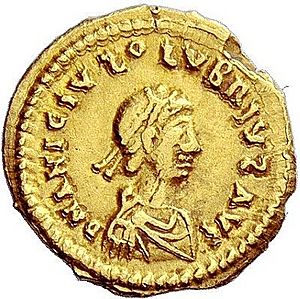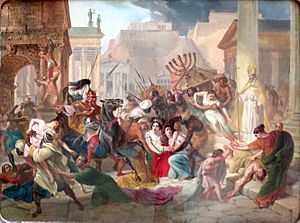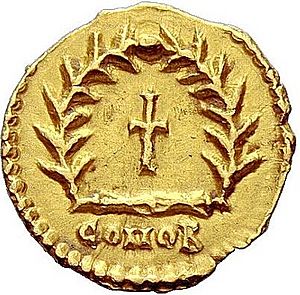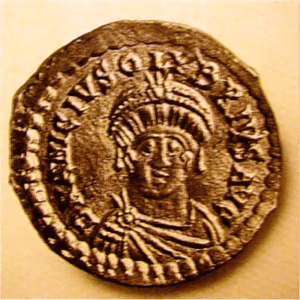Olybrius facts for kids
Quick facts for kids Olybrius |
|||||||||
|---|---|---|---|---|---|---|---|---|---|

|
|||||||||
| Roman emperor in the West (unrecognized in the East) |
|||||||||
| Augustus | 11 July – 2 November 472 | ||||||||
| Predecessor | Anthemius | ||||||||
| Successor | Glycerius | ||||||||
| Co-ruler | Leo I (East) | ||||||||
| Died | 2 November 472 | ||||||||
| Burial | Mausoleum of Honorius, Old St Peter's Basilica (probable) | ||||||||
| Spouse | Placidia | ||||||||
| Issue | Anicia Juliana | ||||||||
|
|||||||||
| Family | Anicia gens | ||||||||
| Dynasty | Valentinianic Theodosian |
||||||||
| Religion | Chalcedonian Christianity | ||||||||
Anicius Olybrius (died November 2, 472) was a Roman emperor who ruled for a short time in 472. He was emperor of the Western Roman Empire, but the emperor in the Eastern Roman Empire, Leo I, did not officially recognize him. Olybrius was mainly interested in religion. The real power behind him was held by Ricimer, a powerful general of Germanic background, and later by Ricimer's nephew, Gundobad.
Contents
Biography
Family and Early Life
Olybrius was born in Rome. He belonged to the ancient and powerful gens Anicia, a noble family from Italy.
Historians believe he was related to a consul named Anicius Hermogenianus Olybrius. Olybrius married Placidia, who was the younger daughter of the Western Roman Emperor Valentinian III (who ruled from 425 to 455). This marriage connected Olybrius to the important Valentinianic dynasty and Theodosian dynasty imperial families.
The exact year Olybrius and Placidia married is not known. Some historians think it happened before the Vandals attacked and sacked Rome in 455. However, the powerful general Aetius had made Emperor Valentinian promise Placidia to his own son. So, Olybrius could not have married her before Aetius died in 454.
After Aetius died, Emperor Valentinian III was also killed in 455. A high-ranking officer named Petronius Maximus became the new emperor. He married Valentinian's widow and tried to strengthen his claim to the throne. Some historians believe Olybrius married Placidia around this time to help Petronius Maximus look more legitimate as emperor.

Becoming a Candidate for Emperor
In June 455, the Vandals, led by King Gaiseric, attacked and sacked Rome. They took Emperor Valentinian's wife and two daughters, including Placidia, as hostages to Africa. Olybrius was in Constantinople (the capital of the Eastern Roman Empire) at this time.
While in Constantinople, Olybrius became very interested in religion. He met a holy man named Daniel the Stylite, who predicted that Placidia would be freed.
Meanwhile, the Western Roman Empire had many emperors in a short time. King Gaiseric of the Vandals wanted Olybrius to become the Western Emperor. This was because Gaiseric's son and Olybrius had married the two daughters of Valentinian III. If Olybrius was emperor, Gaiseric would have more influence over the Western Empire.
So, Gaiseric freed Placidia (Olybrius's wife) and her mother. However, Gaiseric continued to raid Italy's coasts. Gaiseric's plan for Olybrius to become emperor failed at this time. Instead, Ricimer, the powerful general in the West, chose Libius Severus as the new emperor (461–465). Placidia joined Olybrius in Constantinople, and their daughter, Anicia Juliana, was born there in 462.
Olybrius was considered for the Western throne again in 465 after Libius Severus died. Gaiseric again strongly supported him. But the Eastern Emperor Leo I chose Procopius Anthemius instead. Even though Olybrius was linked to Gaiseric, the Eastern court still gave him the high honor of being a Roman consul in 464.
Rise to the Throne
Most historical records agree that Olybrius became the Western Emperor thanks to the powerful general Ricimer.
One story says that Emperor Leo I sent Olybrius to Italy in 472. His job was to help make peace between Ricimer and Anthemius, who was being attacked by Ricimer in Rome. Leo I suspected Olybrius might secretly side with the Vandal king. So, Leo sent another messenger with a secret letter for Anthemius. This letter told Anthemius to kill both Ricimer and Olybrius.
However, Ricimer's guards found the secret letter. When Ricimer showed the letter to Olybrius, Olybrius decided to accept the role of emperor. Ricimer thought Olybrius was a good choice because he was from a noble Roman family and was married to Placidia. This marriage made Olybrius the last emperor connected to the important Valentinianic and Theodosian imperial families in the West. Ricimer then had Anthemius killed, and Olybrius was declared emperor on July 11, 472.
Another version of events does not mention the secret letter. It says that Olybrius was made emperor several months before Anthemius died, possibly in April or May 472. Ricimer then attacked the part of Rome where Anthemius was. After several months, Anthemius's supporters left him. He was captured in a church and killed by Gundobad, Ricimer's nephew. This story suggests that Emperor Leo I might have secretly supported Olybrius, which is why he sent him to Italy.
Reign and Death
Olybrius's time as emperor was very short and quiet. Soon after Anthemius died, Ricimer also passed away on August 9 or 19. Ricimer's nephew, Gundobad, took his place as the main general.
Not much is known about what Olybrius did as emperor. One writer described him as a very religious man. As a sign of this, he had new gold coins made. These coins had a cross on them and the words "SALVS MVNDI" (meaning "Welfare of the World") instead of the usual "SALVS REIPVBLICAE" (meaning "Welfare of the State"). Also, Olybrius is shown on his coins without a helmet or spear, which were common symbols on earlier emperors' coins. This suggests he was not very interested in military matters.
Olybrius owned a palace in Constantinople. He also paid to restore a nearby church called Saint Euphemia in Chalcedon. This was a famous church where an important church meeting, the Council of Chalcedon, had taken place in 451. This act showed Olybrius's connection to the imperial Theodosian dynasty.
Olybrius died from a sickness called dropsy after ruling for only seven months. He most likely died on November 2, 472.
Olybrius in Culture
In 1707, two writers, Apostolo Zeno and Pietro Pariati, wrote a libretto (the text for an opera) called Flavio Anicio Olibrio. The story in this opera is quite different from what really happened. In the opera, Ricimer captures Rome and takes Placidia (Valentinian III's daughter) as a prisoner. Later, Olybrius frees Rome and Placidia, and then marries her.
This libretto was used for an opera by Francesco Gasparini in Venice in 1707. It was also used for an opera by Nicola Porpora in Naples in 1711.
See also
 In Spanish: Olibrio para niños
In Spanish: Olibrio para niños



